Copyright 2020 - 2021 irantour.tours all right reserved
Designed by Behsazanhost
Naqsh e Rostam (Necropolis)

Naqsh-e Rostam (Necropolis)
Opposite the Mountain of Mercy and the turn-off onto the road leading to Persepolis, the living quarters of Achaemenid kings, stands the Necropolis, the magnificent place of their burial. The mountain of Hossein Kuh provides a remarkable natural screen, with the tomb chambers of Achaemenid kings carved into the rock together with Elamite and Sasanid bas-reliefs. The present name of the site is hardly two centuries old. It can be translated as "the Picture of Rostam", and probably derives from the Sasanid carvings, most of which exhibit equestrian combat scenes thought to depict the exploits of Rostam, Iran's most famous legendary hero. Originally, the site may have not had a proper name at all, and was simply called something like "the Burial Place" - reflected in its Greek name, Necropolis ("the City of the Dead").
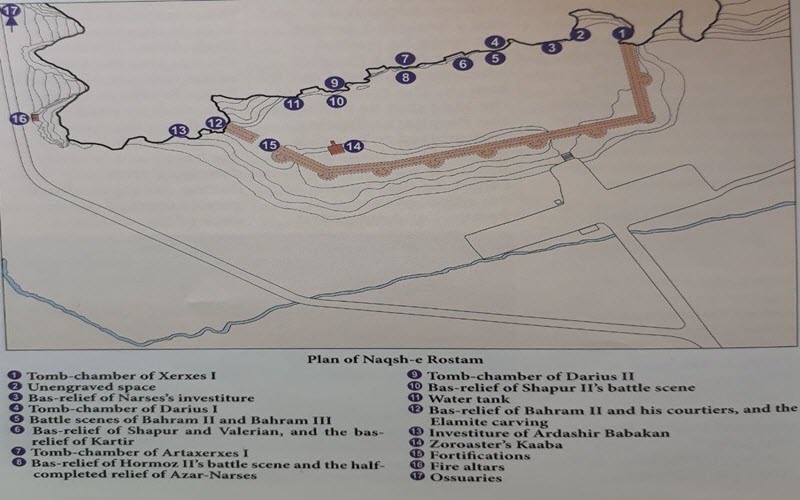 |
Achaemenid Tombs
Naqsh-e Rostam is primarily noteworthy as the burial place of four Achaemenid sovereigns. From right to left, it holds the tombs of Xerxes I, Darius I 4, Artaxerxes I 7, and Darius II 9. In reality, only the tomb chamber of Darius I is marked with the name of its owner, while the other graves have been identified on the basis of archaeological and historical evidence. Thus, the tomb chamber of Xerxes I is ascribed to him because it is outstanding among the tombs for its excellence of execution and preservation - congruent with Xerxes's penchant for artistic perfection. The grave of Artaxerxes I is associated with that king because it is positioned immediately after the tombs of Darius and Xerxes, and therefore is considered to belong to their nearest successor. Following the same line of reasoning, the sepulcher after Artaxerxes's tomb chamber has been identified as that of Darius II. Because there was no room for the graves of the succeeding Achaemenid kings, these rulers were obliged to construct their mausoleums in another place, and this they did - on the Mountain of Mercy overlooking Persepolis.
 |
 |
The four tomb chambers of the Necropolis are virtually identical. They appear on the outside as gigantic crosses, with their bottom edges located high above the ground. Those who hewed the tombs out of the rock at such an elevation thought them to be inaccessible to plunderers; however, the supposed impregnability of the Achaemenid graves proved illusory, and robbers soon found their way to the treasures inside. There was another reason for the lofty placement of the tombs - a symbolic reason rather than a functional one: since ancient people believed that God dwelt in heaven, the higher one's final resting place, the nearer to God.
 |
The entrance is located in the center of the tomb chamber's main transverse limb, which is decorated like the portal of an Achaemenid palace. The whole facade is inset so as to leave a narrow ledge in front of it. Four half-columns with plain shafts, but having ornamental capitals, flank the towering doorway of the grave. This doorway is framed in a case, the decorative treatment of which is an unmistakable loan from Egypt. Together with two plain posts, the half-columns appear to support the entablature of the portal, which has a dentilled cornice. Immediately above the cornice, the upper limb of the cross is decorated with bas-reliefs. These portray a king holding a bow in his left hand, while his right hand is uplifted in a gesture of oath or adoration. He is shown worshipping fire, which blazes in a fire altar in front of him. The fire may have been the personal fire of the king, which was kindled at his accession and kept burning until the end of the reign.
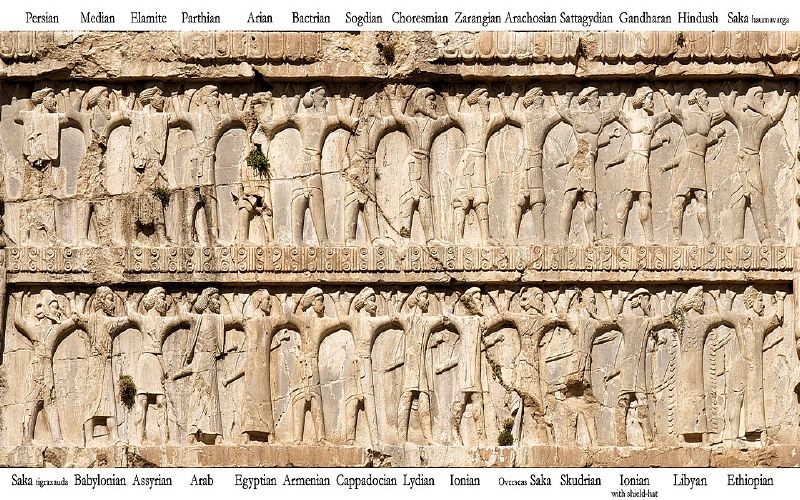 |
| The nationalities mentioned in the DNA inscription are also depicted on the upper registers of all the Tombs at Naqsh-e Rostam. One of the best-preserved is that of Xerxes I. |
The king stands on a dais, which is upheld by two rows of subject peoples of the Achaemenid dominion. Eight of the twenty-eight men on Darius's tomb still bear inscriptions identifying their nationalities. The proportions and the spacing of the figures help to make the effect of the king's image both majestic and unique. Above the king hovers the farr, a representation of royal fortune. He faces the king and lifts one hand in an attitude of benediction, while in the other he holds a ring. In the upper right-hand corner is sculpted a round disk signifying perhaps the sun or the moon. Royal guardsmen and attendants are carved on the inner ledges of the cross. Some traces of pigment found on the facade of the tombs suggest that all or most of the stone reliefs were polychromed. The tomb of Darius I also has an abundance of cuneiform inscriptions praising Ahuramazda and dealing with spiritual and governmental matters. The initial texts are in Old Persian and are often followed by their translations in the Elamite and Assyrian languages.
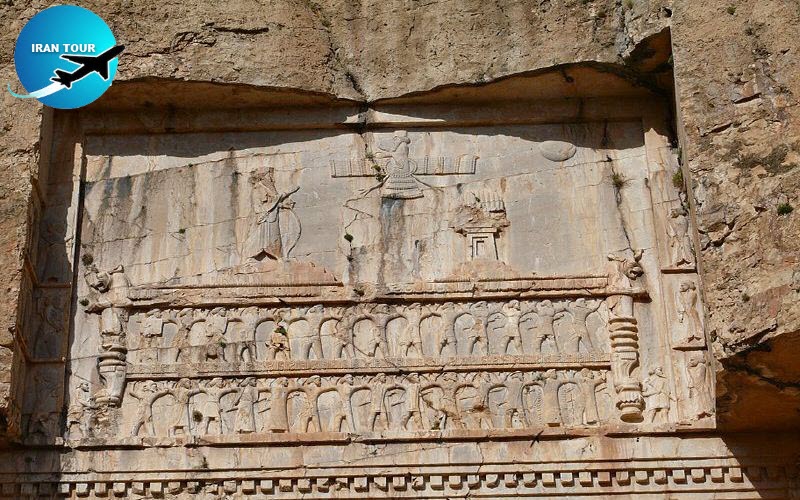 |
Some pathetic stories are attached to Darius's rock vault. One has it that the father and mother of Darius, having expressed a wish to see the progress of the work on their son's future sepulcher, were hoisted by forty Magi ordered to pull on the rope. The clumsy priests, frightened by the sudden appearance of some serpents, let the rope go, and the unhappy couple was dashed to the ground and killed. The forty culprits, for all their sanctity, paid the penalty with their lives. Another story says that for seven years after Darius's demise his favorite eunuch found shelter in the vestibule of his former master's crypt and could not be persuaded to forsake it until his own death. The interior arrangement of the sepulchers varies slightly. In general, however, each sepulcher has three cavities for the deceased, arranged in row sequence. Inside each of these cavities, a coffin was incised en situ. The coffins and the slightly elevated floor of the cavities were all carved out of the same monolith. In the case of Darius I's tomb, however, the crypt was enlarged at the western end, and vaults for six more coffins were provided, so as to make three rows of three crypts each - nine in all. Access to the chambers was provided by means of a wide vestibule extending horizontally inside the entrance to the mausoleum.
Sasanid Bas-Reliefs
Naqsh e Rostam, though never derelict or deconsecrated, attained even more important during the Sasanid period. Today it is the site of the largest collection of Sasanid bas-reliefs in Iran.
Unengraved space
To the left of Xerxes's tomb chamber, there remains a large unengraved space. Obviously, the recess was intended to receive a representation of some important event during the late Sasanid period, but it seems that time ran out for the Sasanid kings before they could carve it. The recess is 10 m long and 5 m high. Compared to early Sasanid bas reliefs, it is carved deeper, perhaps to provide the proposed future engraving with better protection from natural destruction. Some authorities believe that this space was to depict a scene from the life of Khosrow Parviz, and belongs to c. 625. In the 19th century, the unengraved space was used for a Persian inscription with no historical value, an announcement of the irrigation arrangements of a contemporary local landlord. Three small holes, presumably for offerings or tapers, were scooped out.
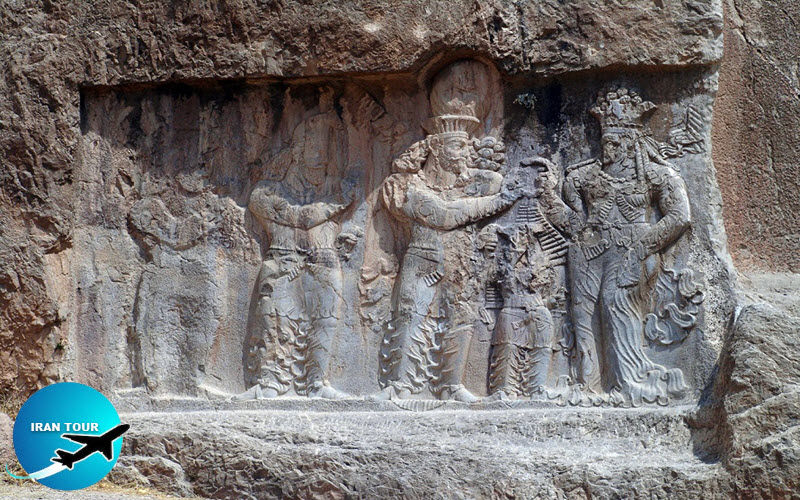 |
carvings, for the reason that some believe that in it the king is receiving his royal insignia not from Ahuramazda, but from Anahita. Certain details of the carving, however, conflict with this popular theory. Because the figure of the king is depicted as taller than that of the goddess (his huge, globe-shaped turban surmounting an old Persian fluted hat even demanded extra space outside the frame of the tableau), and because the female figure hides one hand in her sleeve (in compliance with the Sasanid decree that everyone had to conceal the bare hands in the king's presence), it is more plausible that this lady is actually the royal consort, and that the relief pictures the bonds of the royal family.
 |
King Narses, son of Shapur I, is portrayed with every attribute of royal magnificence. His hair stands out in bushy curls on either side of his handsome face, and his beard is tied in a knot below his chin. He is clad in a close-fitting garment, terminating over loose, flapping trousers. His shoes have ribbon laces. The female figure, in a full-length dress whose train covers even her feet, wears a crown identical to that of Ahuramazda. She sports an elaborate coiffure, with braided hair piled high above her tiara, and long curls spread coquettishly over her shoulders. Like the king, she too has a diadem with a long, wide, crimped ribbon attached to the back. Her beautiful necklace was originally pearl-studded, but the pearls vanished long ago.
A child, perhaps the crown prince Hormoz II, stands between her and the king. Behind the king, a nobleman with a thick beard and braided hair makes the conventional gesture of reverence with his raised hand and bent forefinger. His tall hat terminates in the head of an animal, generally supposed to be a horse. To the left of the nobleman stands another figure, but it is so eroded that its outlines are no longer discernible. This carving dates from approximately 300 A.D., and where it has escaped mutilation, it retains an astonishing sharpness and vigor. The barely discernible remains of an Elamite carving have survived nearby.
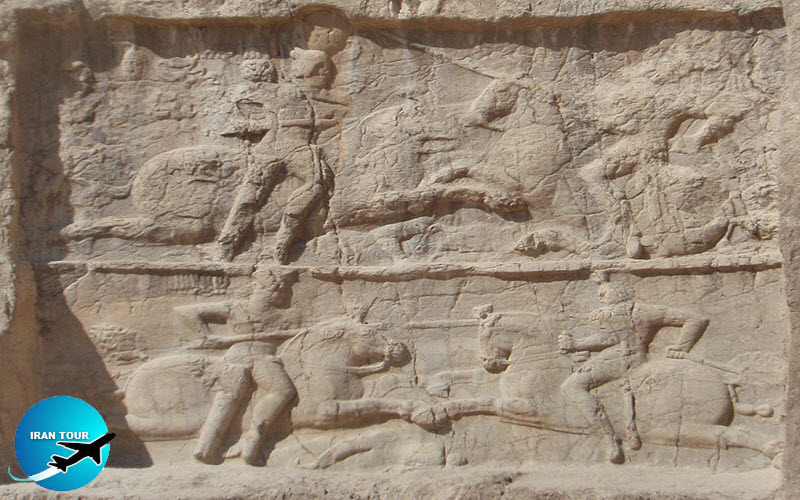 |
Battle scenes of Bahram II and Bahram III
This double relief belongs to a different class of monumental sculptures. It illustrates neither the pomp of regal investiture nor the triumph over a captured foe, but the equestrian prowess of a warrior king. It actually consists of two battle scenes, placed one above the other, and separated by a narrow line. The upper relief shows Bahram II, distinguished by the two eagle wings attached to his crown (the eagle was a symbol of Bahram, patron of victory). The king is engaged in combating his Roman foe. The enemy's mount has fallen down on its haunches. The corpse of another vanquished Roman warrior is shown trampled beneath the hooves of Bahram's steed. This horse is a sumptuously caparisoned and ornate harness, and his mane and tail are lavishly adorned. Behind the king, the outlines of a royal standard are discernible. The lower carving differs only in minor details, but the monarch here is believed to be Bahram III, who had a very short and uneventful reign. The combined panels are invaluable as documents concerning the military equipment of the period.
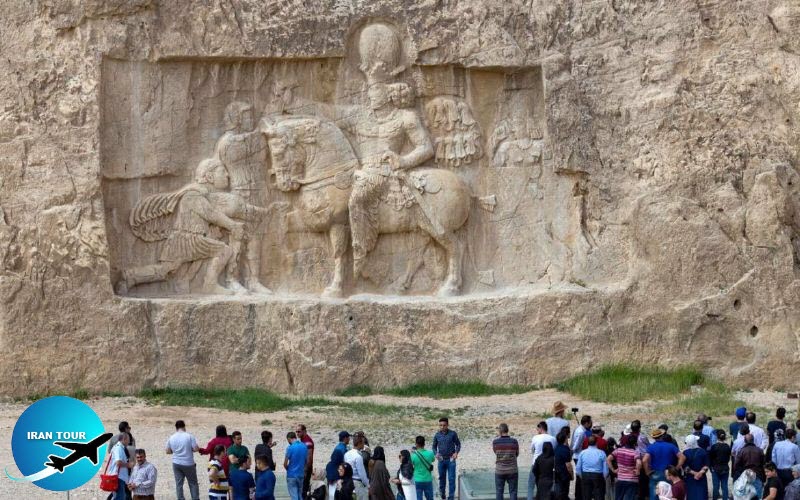 |
The victory of Shapur I over Valerian
One of the most famous carvings of the Sassanid era, this relief depicts the victory of Shapur I over the Roman Emperor Valerian in the year 260 A.D. Although this outstanding achievement of the Sasanid king (who managed to prevail in face-to-face combat with Valerian and take the emperor captive) has been portrayed repeatedly in carvings throughout Shapur's realm, this carving at Naqsh-e Rostam is the most spectacular. It is overwhelming in its sweeping scale and the delicacy of its craftsmanship. Earlier analogies of this bas-relief can be found in Darab and in the Chogan Gorge. In addition, a trilingual inscription on the walls of Zoroaster's Kaaba gives a detailed account of this event.
In the carving, Shapur I is shown mounted on a warhorse. This is the only portrait of Shapur showing the left profile of the king (facing left). The monarch displays handsome features so familiar from sculptures and coins. He has a curly beard, tied in a knot below his chin, and long hair flowing behind his shoulders. He wears a crenelated crown surmounted by a large, globe-shaped turban - the korymos. His headgear further includes a diadem, to the back of which a long crimped ribbon, a hallmark of power, is attached. The monarch wears wide, pleated trousers, together with a loose shirt, and a cape fastened with two round buttons. The cape flies out behind him in the wind. The king's long sword remains in its sheath, which he grasps with his left hand. His right hand is stretched forward to grip the right wrist of a man dressed in Roman clothes. The king's horse is also beautifully equipped.
 |
In front of Shapur, Philip the Arabian is shown kneeling, and stretching his hands in supplication. Philip's wide cape, fastened at the shoulder with a round button, streams in the wind behind him. (This wind, of course, blows in the opposite direction from that which swells the king's coat. Obviously a symbolic rendering, it perhaps implies only the existence of the wind, while disregarding its direction, or even sacrificing a literal depiction to symmetry. Alternatively, the movement of the clothing may symbolize the forward motion of the figures approaching one another from opposite directions.) A sheathed sword with a cross-like hilt is secured at Philip's waist. There is a very satisfying sense of arrested motion; one can easily imagine that Shapur's horse has suddenly stopped as the desperate Philip rushes forward to beg for mercy. The other man, in Roman clothes and facing Shapur, is Valerian. His right hand, hidden in a long sleeve, is gripped by Shapur in the traditional gesture of capture on the battlefield. The relief is about 11 m long and 5 m wide.
Behind Shapur is carved a bust of Kartir and a long inscription in Sasanid Pahlavi - both later additions (dating from c. 280). The inscription has forty-eight lines. It gives the name and lineage of Shapur, as well as an account of Kartir's own endeavors dedicated to the reinforcement of the Zoroastrian creed. The priest and the chief judge of the empire" are shown wearing a tall hat with a scissor-shaped emblem. A heavy necklace of large roundels adorns his neck. Oddly, the magus is here shown beardless. He raises his right forefinger towards Shapur in a gesture of adoration. (In Achaemenid art, the person, showing respect bowed before the king and covered his mouth with his hand, while in Parthian art, the bent right hand was raised with an open palm shown to the revered person. Then again, in Sasanid art, the one who wanted to show respect raised his bent index finger in front of his face.)
The inscription of Kartir runs: "And I wrote this memorial for this reason that I, Kartir, since long ago have set my seal upon many documents and charters relating to fire and magic rites of different rulers and lords, and my own name has often been written in several places of such documents, charters, and records, so that whosoever at a future time may see a charter, a record or a document, or some other memorial may know that I am Kartir, who under Shapur, King of Kings, was called 'Kartir, the mobed, and herbod, and under Hormoz, the son of Shapur, was called Kartir, the mobed of Ahuramazda and under Bahram [Bahram III), King of Kings, son of Bahram (Bahram II), was called 'Kartir, whose soul (God) has saved, the mobed of Ahuramazda.
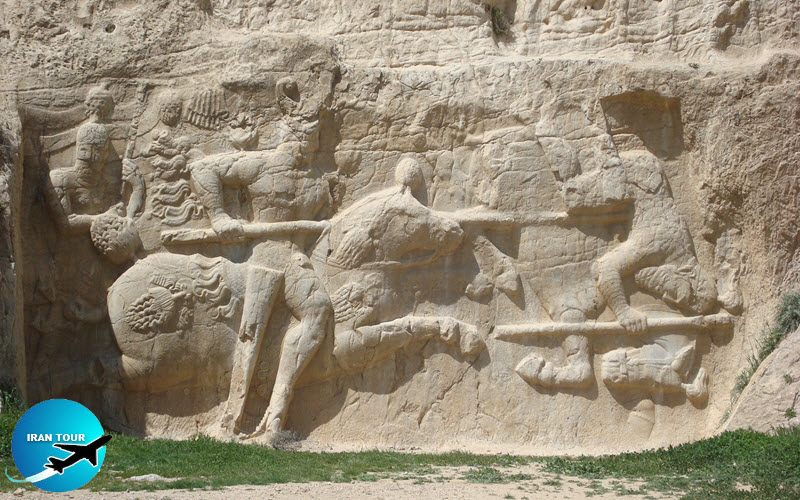 |
Battle scene of Hormoz II and relief of Azar-Narses
Although the lower carving is much mutilated, many details of the equestrian combat it depicts are still discernible. The upper carving, however, has been almost completely eroded. The lower scene shows the victory of Hormoz II over his adversary. The king's face has been destroyed, but enough of his crown has preserved to allow historians to identify the figure. The king's enemy wears a plumed helmet and seems to be the governor of Georgia. The Persian monarch must have been a man of great strength, for his blow has completely upended the enemy and his horse. The figure of a royal standard-bearer follows the king.
This carving is 8.4 m long and 4 m wide. The upper carving is barely discernible, but careful observation reveals the figure of a dignitary seated on the throne. His hands rest on what is either a sword or a mace, and two persons stand on either side of him. The upper carving slightly overlaps and spoils part of the lower carving, but spares the figure of Hormoz. For this reason, historians believe that the upper relief was executed at a later date and that its originator had a close relationship with the king. Consequently, many consider that the carving depicts Azar-Narses, son of Hormoz, who succeeded his father on the throne. The carving has been left unfinished, a fact which strengthens this theory, since it is known that Azar-Narses ruled for only a few months.
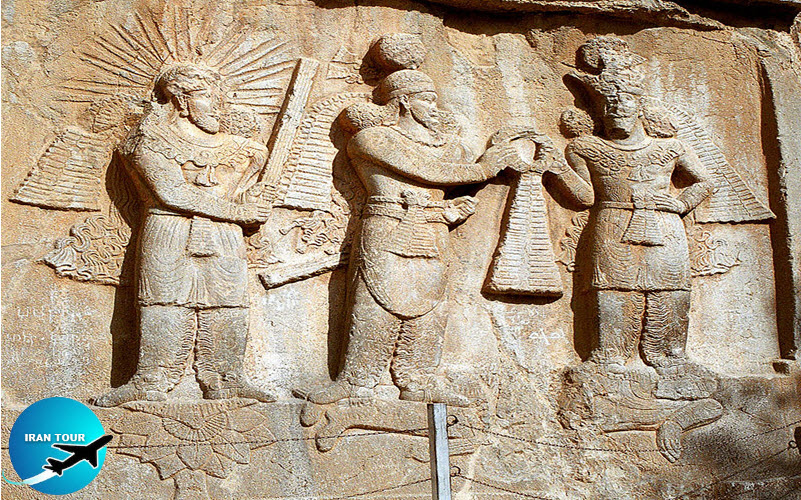 |
| Sassanian relief of the investiture of Ardashir II showing Mithra, Shapur II\ and Ahura Mazda above a defeated Julian, lying prostrate |
Battle scene of Shapur II
This carving has also been largely destroyed, and many of its details have disappeared. The date of this carving and the identity of the king have not been identified with certainty, but historians believe him to be Shapur II. This conjecture stems from a comparison of what has survived of the head and helmet of the person in the bas-relief, with the portraits of this Sasanid monarch found on his coins. On the other hand, many authorities believe that the relief may as well represent Shapur III.
The king best rides his fiery, prancing horse. He attacks his enemy, who wears a Roman helmet. A standard-bearer is shown behind the monarch. He bears a standard consisting of three spheres affixed to the upper side of a horizontal rod; two tassels hang below the rod. This may be the banner that Ammianus Marcellinus, 4th-century-A.D. Roman historians claimed Sasanid armies always carried in their battles. The king dashes ahead of his standard-bearer to attack the enemy, whose spear is broken and whose horse has fallen on its haunches. What makes this carving different from the other reliefs of Naqsh-e Rostam is the unnaturally large size of the horses - the principal reason that some scholars have ascribed the carving to the later date of Shapur III's rule. This carving is 7.6 m long and 3 m high.
Water Cistern
The area of Naqsh-e Rostam had a stone water cistern, the remains of which have been excavated at the foot of the mountain. The cistern may have been used by sentinels and visitors to the site during the Sasanid rule. It may also have had a special function during religious ceremonies. The water cistern is built in the shape of an irregular pentagon, with its longest side measuring 7.2 m, and the other sides 5.5 m. It is reminiscent of the cistern in Persepolis near Artaxerxes II's crypt. The cistern of Persepolis is 26 m deep, but the depth of the reservoir in Naqsh-e Rostam is unknown. The style and techniques employed in the construction of both cisterns are identical, and it may be presumed that they were both carved out around the same date.12 Bahram II and an Elamite carving This carving, dating from c. 290 A.D., differs entirely, both in subject and treatment, from the majority of Sasanid bas-reliefs. Chiseled on a projecting surface of the rock, it follows the contour of the cliff. In the center, it shows a full-length figure of Bahram II, surrounded by busts of members of the royal family and courtiers. The king holds a long sword with both his hands. He wears a crown adorned with eagle's wings and topped by a tall, round turban. On the king's left are shown three noblemen, obviously courtiers. The five figures on the king's right are presumably members of the royal family. The carving is roughly 7 m long and 2.5 m wide.
What is particularly remarkable about this bas relief is that it was carved over an Elamite engraving, which was erased to make room for a portrait of the Sasanid king. The outlines of the Elamite carving are barely visible today, but we can get an idea of what it looked like by comparing it with the relief of Kurangun (p267). The middle of the scene originally showed a king and a queen, each sitting on a coiled snake as if on a throne, and surrounded by people paying tribute to the couple. Parts of the Elamite carving have survived on either side of the Sasanid relief. Dating from the New Elamite Age in the Ist millennium B.C. the section on the right shows an Elamite king wearing a long robe and a skullcap. On the left may be seen the crowned head of a queen.
Above this relief, on the peak of the mountain, a cylindrical column is carved out of the rock. It does not appear to have belonged to any building and may have fulfilled some memorial or votive purpose. Nearby, seen only if one climbs the cliff, is a flat stone with a depression in the middle; this is conjectured to have served as a platform for the exposure of the Zoroastrian dead.
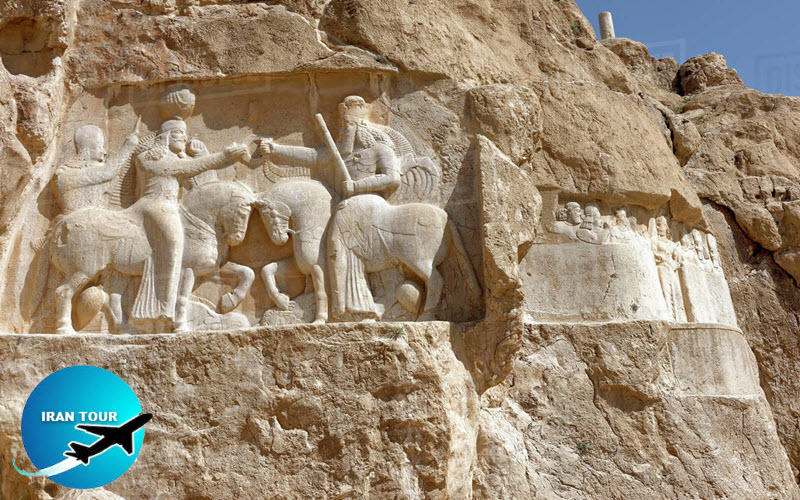 |
Investiture of Ardashir Babakan
Dating from the very end of Ardashir Babakan's reign, the scene shows the investiture of this monarch. It seems quite illogical for a king at the end of his reign, and particularly for one who is known to have transferred his power to his son considerably before his death, to have chosen this moment to record his coronation ceremony. It seems, thus, that the scope of this scene's iconography cannot be limited to that of the brief moment of the actual investiture. Rather, it is to be seen as having the broader connotation of royal apotheosis. This is an allegory of the concept of divine kingship, so popular in the ancient Near East.
The two figures are shown on horseback facing each other; they stand in a symmetrical arrangement as mirror images. The king (on the left) is identified by a distinctive helmet with a border protecting his ears and neck. The helmet is topped with a globe-shaped turban. The king's headdress is completed by a diadem, which has a crimped ribbon attached to the back. The monarch is clad in opulently-adorned ceremonial clothes. He stretches out his right hand to receive a circlet of royal power presented to him by Ahuramazda. With his upraised left hand clenched into a fist with bent forefinger, the king salutes the deity as it was customary under the Sasanians. Behind Ardashir, a page holds a fly whisk over the sovereign's head, in the manner frequently seen in the reliefs in Persepolis.
Ahuramazda (on the right), looking very much like the king except for his headgear and square-tipped beard, gives the royal circlet to the monarch with his right hand while in his left hand he holds a bundle of twigs, perhaps the symbol of divinity. The horses of both figures are handsomely decorated. On their chests are inscriptions written in Sasanid Pahlavi, Greek, and Parthian. This seems to be the earliest-known instance of the use of the Sasanid Pahlavi language. Beneath the hooves of Ardashir's horse lies a lifeless body; some are convinced it is that of Artabanus V. The figure trampled by Ahuramazda's horse is a representation of Ahriman, the evil deity; serpents coil around his head. The carving measures 6.5 m wide and 2.4 m high.
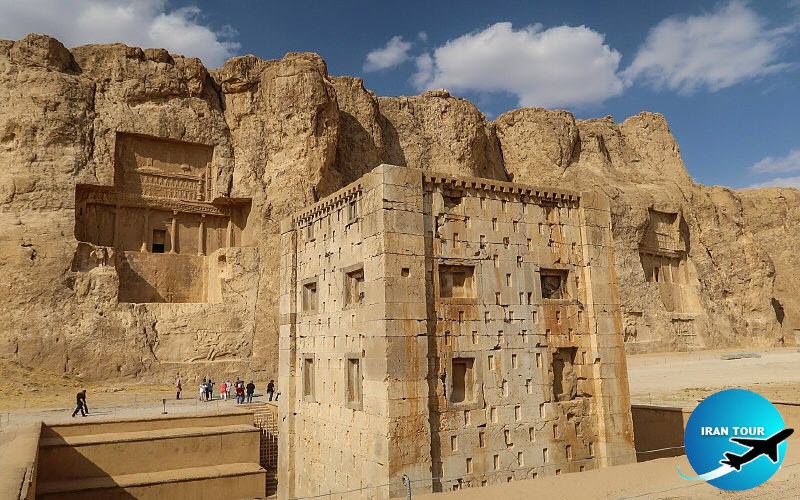 |
Zoroaster's Kaaba (Kaabe-ye Zartosht)
Zoroaster's Kaaba is the most conspicuous freestanding building of Naqsh-e Rostam. The building's original name is unknown; nowadays it is called Kaabe-ye Zartosht ("Zoroaster's Kaaba"). This name is relatively modern and was bestowed on it by European travelers who visited the site during the 19th century. The building may have originally been called Bon-Khaneh (“the Principal House”), the name mentioned in Kartir's inscription on the wall of the building. What is more, the building's function is also unknown. Attempts to ascertain its real purpose have produced a flood of archaeological speculation, with interpretations that press intellectual resourcefulness and imagination up to their rational limits and beyond. Some scholars have claimed that it was a fire temple, giving no consideration to the fact that a closed chamber with no ventilation seems inconsistent with such a purpose. Others have believed that the mummified bodies of the kings were kept here prior to their placement inside the crypts. The difficulty of access, however, invalidates this theory as well. Still, others have thought it to be the tomb of Hystapes, Darius's father, while a similar structure in Pasargadae (pp339355) has been called the tomb of Cambyses, son of Cyrus. Other explanations are that the building was a storehouse for religious and governmental relics, or even a huge sundial - a sort of primeval astronomical computer - used for calculating the spring equinox, an important reference point of the Iranian calendar. Dating from the 6th century B.C., Zoroaster's Kaaba is composed of twenty horizontal courses of smoothly carved limestone blocks placed one on top of the other without mortar. A stairway of twenty-nine steps on its northern side leads to the building's single interior chamber; below the chamber the building is solid. The roof of the chamber is made of four stone slabs placed so as to form a low pyramid, which allowed rainwater to drain off. The chamber was possibly opened and closed by means of a stone door turning on pivots.
The exterior of the building is ornamented with rows of blind windows highlighted by frames of black basalt, and by numerous shallow, rectangular niches set out in a checkerboard pattern. The precision and skill showed in the cutting and alignment of the stones, together with the astonishing symmetry observable in this building, speak of the masterly competence of the builders and masons of the Achaemenid age. Today the building seems to have sunk into the ground. This, however, is an illusion: the original ground level is that on which the building now stands, while the area around has risen in height due to many centuries' accumulation of soil and debris.
The bottom stones of the building exhibit the longest inscription in Sasanid Pahlavi. Its thirty-five lines on the eastern wall are not readily seen from above. Complemented by its translation in Parthian (on the western wall) and Greek (on the southern wall), it gives an account of Shapur I's victorious campaigns against Rome. The Greek inscription is particularly remarkable because it seems to be the last instance of the use of Greek in Iranian writings. Another inscription on the building's eastern wall belongs to Kartir. In its nineteen lines, the Great Magus enumerates his deeds in the dissemination of the Zoroastrian faith. Like two other inscriptions belonging to Kartir, in Naqsh-e Rostam and Naqsh-e Rajab, this is a copy of his original message carved in Sar-Mashhad (p291) and today kept in the Persepolis Museum.
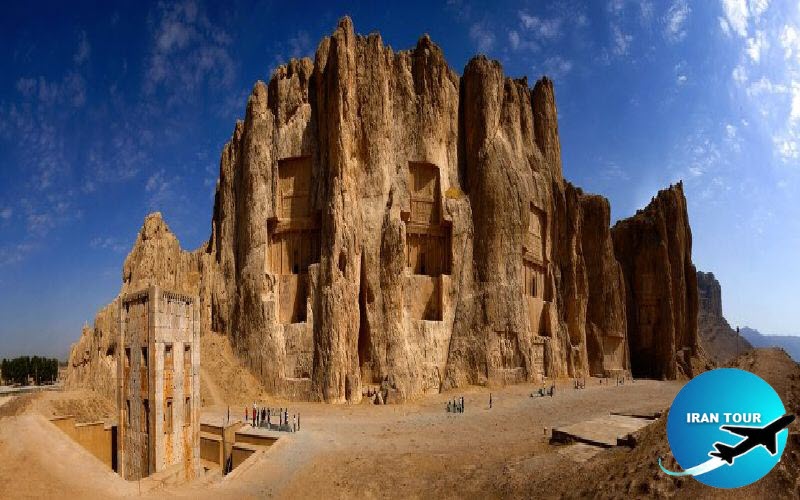 |
Fortifications
Throughout the Sasanid period, the enclosure of Naqsh-e Rostam was fortified, and sentinels guarded it against invaders. The enclosed area comprised a rectangle about 200 m long and 70 m wide. The northern side backed onto a mountain, while three other sides were enclosed with a mud-brick rampart. The wall was about 9 m thick and was topped with watchtowers constructed at intervals of 21 m. The entrance gate was possibly located on the east side. Curiously, the bas-reliefs of Bahram and Ardashir were outside the enclosed area, though they had obviously been carved prior to the period when the walls were built around Naqsh-e Rostam. In building the walls, it is possible that the Sasanians followed an earlier, probably Achaemenid plan.
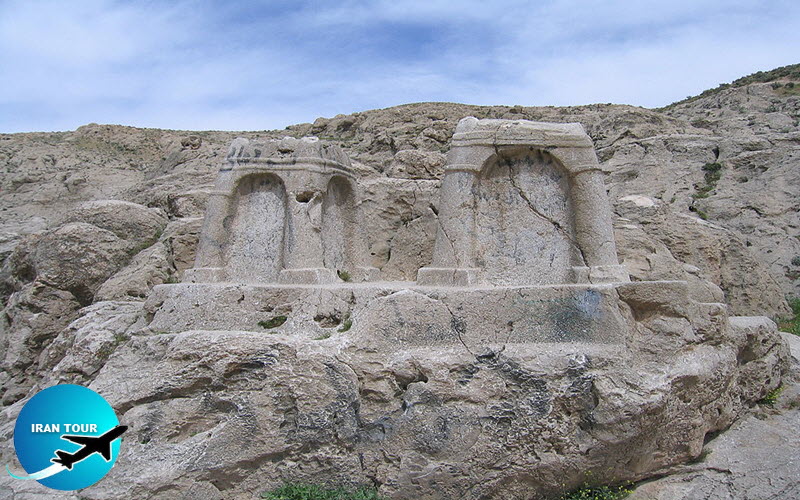 |
Fire Altars
Outside the present enclosure of Naqsh-e Rostam, at the western extreme of Mount Hossein Kuh, there stand two small stone towers. Dating from the Achaemenid age, they have been carved out of the solid rock. They are similar in appearance, except that one is slightly larger than the other. The southern structure has a base of 1.3 by 1.3 m and is 1.5 m high. The two structures stand side by side on a platform that has a flight of three steps on its south side. The sides of the altars are built in the form of filled-in arches, with an engaged column at each corner.
Each tower has a depression on top; this has a surface measurement of about 40 by 40 cm and is 15 cm deep. Either the towers must have been places for fire worshipping (thus being perhaps the oldest Zoroastrian relics in Iran), or else they served as a type of charnel-houses, where bones of the dead were kept until stripped of flesh.
Ossuaries
About 300 m north of the fire altars, the lower parts of the cliff face are pierced with small, rectangular, box-like hollows. These are ossuaries where Zoroastrians kept the bones of their dead.
- Details
- Category: Museums of Shiraz























